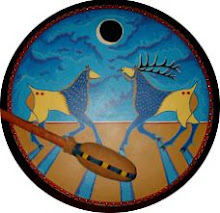Maschera di essere mitologico- opera dell'artista Nativo Joe David
Una leggenda Ojibwa
Un inverno una coppia appena sposata andava a caccia insieme ad altri del villaggio. Ma proprio mentre si trasferivano sul territorio di caccia nacque il bambino che aspettavano. Un giorno mentre giocavano con il piccolo dentro la sua culla, chiamandolo per nome, il bambino parlò loro. Erano molto sorpresi perché era troppo giovane per parlare. "Dove è Manidogisik (Spirito del Cielo)?" chiese il bambino. "Dicono che è molto potente e io un giorno andrò a fargli visita." Sua madre lo afferrò e gli disse: "Tu non devi parlare di Manido in quel modo!" Qualche sera dopo dormivano di nuovo con il bambino nella sua culla posta in mezzo a loro. Nel mezzo della notte la madre si svegliò e scoprì che il suo bambino era sparito. Si svegliò anche il marito e si alzò, accese il fuoco e guardò in tutto il wigwam. Cercarono anche fuori attorno al wigwam del vicino, ma non riuscirono a trovarlo. Accesero allora torce di corteccia di betulla e chiesero alle persone del villaggio di aiutarli a cercare delle tracce. Finalmente trovarono alcune tracce molto piccole che portavano al lago. A metà strada verso il lago, trovarono la culla ed ebbero la conferma che lo stesso bambino aveva lasciato quelle tracce, aveva strisciato fuori dalla sua culla ed era andato a cercare Manidogisik. Ma le tracce che portavano dalla culla fino al lago erano grandi, molto più grandi di quelle di piedi umani, e i genitori capirono che il loro bambino si era trasformato in un Windigo, il mostro terribile fatto di ghiaccio che poteva mangiare gli esseri umani. Ma Manidogisik aveva 50 piccoli esseri chiamati manidog per proteggerlo. Quando uno di questi manidog tirava una pietra, essa era come un fulmine. Appena il Windigo si avvicinò, i manidog lo sentirono arrivare e corsero incontro a lui cominciando a combattere. Alla fine lo buttarono giù con uno dei fulmini/pietra che potevano lanciare. Il Windigo cadde morto con lo schianto di un grande albero. Mentre giaceva a terra assomigliava ad un Indiano, anche se enorme, ma quando le persone iniziarono a tagliarlo in pezzi egli era come un enorme blocco di ghiaccio. Bruciarono e sciolsero tutti i suoi pezzi e trovarono così, nel centro del suo corpo, un bambino molto piccolo di circa sei centimetri di lunghezza con un buco in testa dove il manidog lo aveva colpito. Questo era il bambino che si era trasformato in un Windigo. Se il manidog non l'avesse ucciso, il Windigo avrebbe divorato l'intero villaggio.
(Da Robert E. Ritzenthaler and Pat Ritzenthaler, 1983, The Woodland Indians of the Western Great Lakes, Prospect Heights IL: Waveland Press.)
------------------------------------------------
One winter a newly married couple went hunting with the other people. When they moved to the hunting grounds a child was born to them. One day, as they were gazing at him in his cradleboard and talking to him, the child spoke to them. They were very surprised because he was too young to talk. "Where is that manidogisik (Sky Spirit)?" asked the baby. "They say he is very powerful and some day I am going to visit him. "His mother grabbed him and said, "You should not talk about that manido that way. "A few nights later, they fell asleep again with the baby in his cradleboard between them. In the middle of the night the mother awoke and discovered that her baby was gone. She woke her husband and he got up, started a fire and looked all over the wigwam for the baby. They searched the neighbor's wigwam but could not find it. They lit birchbark torches and searched the community looking for tracks. At last they found some tiny tracks leading down to the lake. Halfway down to the lake, they found the cradleboard and they knew then the baby himself had made the tracks, had crawled out of his cradleboard and was headed for the manido. The tracks leading from the cradle down to the lake were large, far bigger than human feet, and the parents realized that their child had turned into a windigo, the terrible ice monster who could eat people. They could see his tracks where he had walked across the lake. The manidogisik had fifty smaller manidog or little people to protect him. When one of these manidog threw a rock, it was a bolt of lightning. As the windigo approached, the manidog heard him coming and ran out to meet him and began to fight. Finally they knocked him down with a bolt of lightning. The windigo fell dead with a noise like a big tree falling. As he lay there he looked like a big Indian, but when the people started to chop him up, he was a huge block of ice. They melted down the pieces and found, in the middle of the body, a tiny infant about six inches long with a hole in his head where the manidog had hit him. This was the baby who had turned into a windigo. If the manidog had not killed it, the windigo would have eaten up the whole village. (Adapted from Robert E. Ritzenthaler and Pat Ritzenthaler, 1983, The Woodland Indians of the Western Great Lakes, Prospect Heights IL: Waveland Press.)

Il Windigo in un opera di N. Morrisseau-1964
Tipica culla delle Pianure del Nord- forse Nez Percé



























